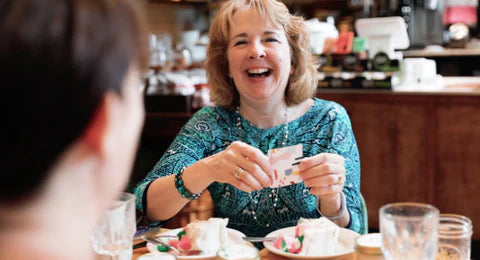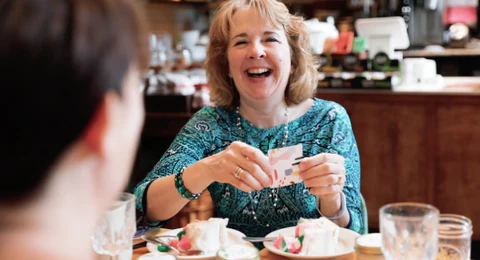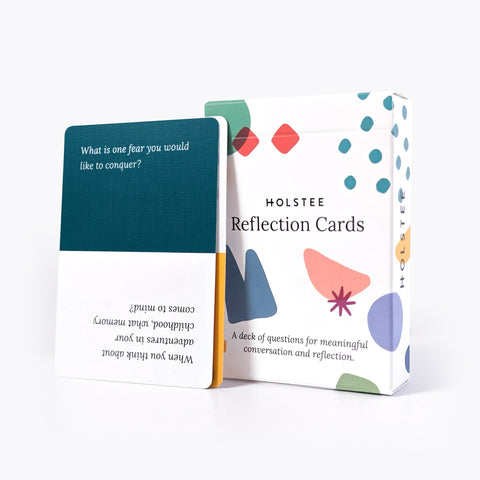Ever found yourself in a social setting, wanting to strike up a conversation but unsure how to break the ice? You're not alone. Starting a conversation can sometimes feel daunting, but with the right conversation starters, you can confidently initiate engaging discussions. In this article, we'll explore the importance of good conversation starters, the art of breaking the ice, preparing your mind for engaging conversations, ten effective conversation starters, and tips for successful implementation. Let's get started!

Understanding the Importance of Good Conversation Starters
The Role of Conversation Starters in Social Interactions
Social interactions play a crucial role in our lives. They allow us to build connections, expand our networks, and even find new opportunities. At the heart of these interactions are conversation starters. Conversation starters act as catalysts, paving the way for meaningful dialogues. They provide the initial spark that ignites communication and helps establish a rapport with the other person.
Imagine a scenario where you walk into a room full of strangers. The first step towards breaking the ice and making connections is often through a well-thought-out conversation starter. It sets the stage for further interactions and can lead to long-lasting relationships. Whether it's a casual chat at a social gathering or a professional networking event, the impact of a good conversation starter should not be underestimated.
Why Effective Conversation Starters Matter
Effective conversation starters make a lasting impact. They create a positive first impression and set the tone for the conversation. When done right, they grab the other person's attention, make them feel comfortable, and encourage them to open up. Engaging in a meaningful conversation becomes easier when both parties feel at ease.
Moreover, good conversation starters can also showcase your personality and interests. They can reveal common ground between individuals, leading to deeper connections and shared experiences. By showing genuine curiosity and thoughtfulness in your conversation starters, you demonstrate your willingness to engage and connect on a more profound level.
The Art of Breaking the Ice
Defining 'Breaking the Ice'
Breaking the ice refers to the act of initiating a conversation in a new or unfamiliar social setting. It involves making an initial connection with someone you don't know well or have never met before. Breaking the ice can help alleviate tension and awkwardness, making social gatherings more enjoyable for everyone involved.
When breaking the ice, it's essential to be mindful of cultural differences, social norms, and individual preferences. What may work as a successful icebreaker in one setting might fall flat in another. Therefore, adapting your approach based on the specific context and the person you're engaging with is crucial for a successful interaction.
The Psychology Behind Icebreakers
Icebreakers are rooted in the psychology of human interactions. They serve as conversation catalysts by stimulating curiosity, triggering emotions, and engaging the other person's interest. When chosen carefully, icebreakers can tap into shared experiences and common interests or simply invoke a sense of humor, making the conversation light-hearted and enjoyable.

Moreover, the use of icebreakers can also help establish rapport and build trust between individuals. By creating a positive and engaging atmosphere from the start, icebreakers set the tone for further interactions and pave the way for meaningful connections to form. Understanding the underlying psychological principles behind effective icebreakers can empower individuals to navigate social situations with confidence and authenticity.
Preparing Your Mind for Engaging Conversations
The Importance of Confidence in Starting Conversations
Confidence is key when it comes to starting conversations. Believe in yourself and your ability to connect with others. Practicing self-affirmation and positive self-talk can help boost your confidence. Remind yourself that you have valuable insights and stories to share and that others will appreciate the effort you put into initiating conversation.
Furthermore, it's essential to remember that confidence is not about being perfect or always having the right thing to say. It's about being comfortable with who you are and being open to learning from each interaction. Confidence can be cultivated through practice, so don't be discouraged by any initial feelings of self-doubt. Embrace the opportunity to grow and improve with each conversation you engage in.
Overcoming Fear of Rejection in Conversations
Fear of rejection can hold us back from initiating conversations, but it's important to remember that rejection is a natural part of life. Not everyone we approach will be receptive to conversation, and that's okay. Embrace the mindset that rejection is simply a redirection towards more compatible connections. Don't let a fear of rejection hinder your ability to connect with others.

Photo by Joice Kelly
Moreover, it's worth noting that rejection in conversations is often not a personal reflection of your worth or likability. People's receptiveness to conversation can be influenced by various factors such as their mood, current situation, or personal preferences. By understanding this, you can approach conversations with a sense of empathy and understanding, knowing that the outcome is not solely determined by your actions. Keep an open mind and be resilient in the face of rejection, using it as an opportunity to learn and grow in your communication skills.
10 Effective Conversation Starters
Using Open-Ended Questions as Conversation Starters
Open-ended questions are conversation starters that require more than a simple yes or no answer. They encourage the other person to share their thoughts, experiences, and opinions, thereby fostering deeper conversation. Examples of open-ended questions include "What do you enjoy doing in your free time?" and "What's the most memorable trip you've ever taken?"
When using open-ended questions as conversation starters, it's important to actively listen to the responses. Show genuine interest in what the other person is sharing and ask follow-up questions to delve deeper into the topic. This demonstrates that you are engaged in the conversation and value the other person's perspective, leading to a more meaningful interaction.
Utilizing Compliments as Icebreakers
A genuine compliment can go a long way in breaking the ice. It shows that you've taken notice of something positive about the other person. Compliments about their appearance, style, or recent accomplishments can make them feel valued and appreciated. Remember to be sincere in your compliments and avoid any insincere flattery.

When offering a compliment as an icebreaker, try to make it specific and personal. Instead of a generic compliment, such as "You look nice," consider something more detailed, like "That color really suits you; it brings out your eyes." Personalized compliments show that you've paid attention and are genuinely interested in the other person, setting a positive tone for the conversation.
The Power of Shared Interests in Starting Conversations
Finding common ground is an effective way to break the ice. Discovering shared interests can create an immediate connection and provide a natural gateway into the conversation. Whether it's a mutual hobby, a favorite book, or a shared love for a particular sports team, expressing genuine interest in the other person's passions can spark engaging discussions.

When exploring shared interests as conversation starters, be open to learning from the other person. Even if you're not familiar with a particular hobby or topic, expressing curiosity and asking questions can show your willingness to engage and connect. Sharing experiences and insights related to common interests can lead to a more meaningful and enjoyable conversation for both parties.
Tips for Successful Implementation of Conversation Starters
Reading Body Language and Non-Verbal Cues
Pay attention to the other person's body language and non-verbal cues. Are they receptive to the conversation? Do they appear engaged and interested? Adjust your approach accordingly. If they seem disinterested or uncomfortable, gracefully transition the conversation to a different topic or politely excuse yourself. Respect boundaries and be mindful of the other person's signals.
Body language can reveal a lot about a person's feelings and thoughts. For example, crossed arms may indicate defensiveness or discomfort, while leaning in and maintaining eye contact can signal interest and attentiveness. Being attuned to these cues can help you gauge the other person's comfort level and tailor your conversation style to create a more positive interaction.
The Role of Active Listening in Conversations
Active listening is a vital skill to ensure successful conversations. Show genuine interest in what the other person has to say by maintaining eye contact, nodding in agreement, and providing appropriate verbal cues. Avoid interrupting and truly listen to understand, rather than simply waiting for your turn to speak. Engage in meaningful dialogue by asking follow-up questions and showing a genuine desire to learn from the other person's experiences.
Furthermore, active listening involves not only hearing the words spoken but also understanding the emotions and intentions behind them. By empathizing with the speaker and demonstrating that you value their perspective, you can foster a deeper connection and create a more enriching conversation experience for both parties.
By understanding the importance of good conversation starters, mastering the art of breaking the ice, preparing your mind for engaging conversations, and implementing effective conversation starters, you can confidently navigate social interactions. Remember, the key to successful conversations lies in genuine connection, active listening, and a willingness to explore new perspectives. So go ahead, break the ice, and watch as engaging conversations unfold!
Unleash the power of reflection and connection. Get your Holstee Reflection Cards today!





